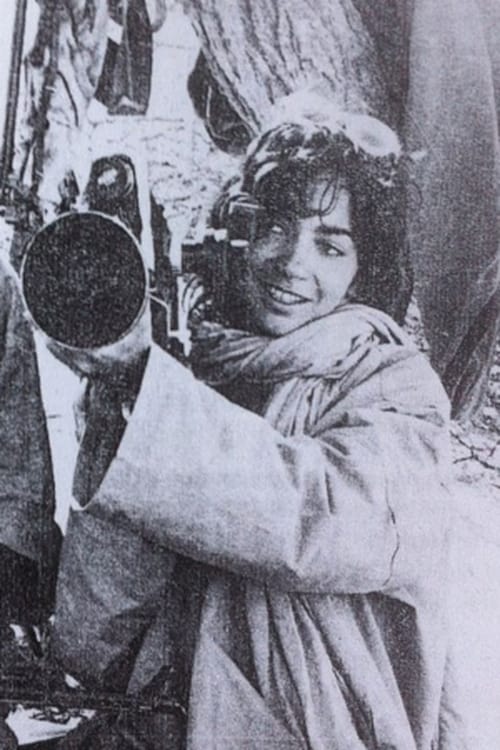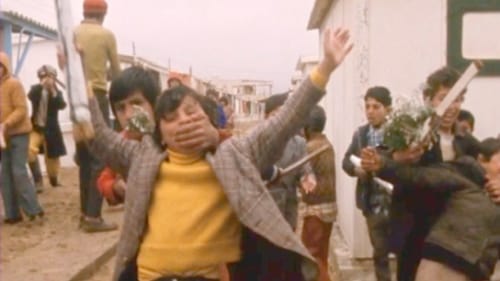
Jocelyne Saab
Nascimento : 1948-04-30, Beirut, Lebanon
Morte : 2019-01-07
História
Jocelyne Saab is a filmmaker and a photographer. She was born in 1948 and grew up in Beirut. In 1973, she became a war reporter in the Middle-East, covering the war of October for Magazine 52, the third television channel in France. In 1975 she directed her first feature film, a documentary released in Parisian cinemas: Lebanon in Turmoil, distributed by Pascale Dauman. She will then cover the Lebanese war for fifteen years, during which she directs almost thirty films, including Beirut, never again, broadcasted on France 2 in 1976, Letter from Beirut and Beirut, my city, broadcasted on France 3 between 1978 and 1982. In 1977 both Egypt, City of the Dead and The Sahara is not up for sale and were shot and released in Parisian cinemas. In 1981, she shots Iran, Utopia in the making on the days following the Iranian revolution, which received several international prizes. In 1998, she went to Vietnam and directed a documentary called The Lady of Saigon, which is awarded best French documentary by the French senate. It’s broadcasted on France 2, and in many international festivals.

Director
A delicate portrait of Mei Shigenobu, daughter of the founder of the Japanese Red Army in Beirut, Fusako Shigenobu.

Director
An imaginary post card written to the Turkish writer Orhan Pamuk. Jocelyne Saab writes about her illness, about the fragility of her body, and the situation in the Middle East that is ravaged by war.

Director
Six 4-minute short films each filmed in the countries of the Mediterranean, and dealing with expressions of gender, the body, sexuality and identity. Six interviews with artists or people talking about these thorny issues makes for a geographical impression, a suffering body, subject to violence, repression and inhibition.

Director
At bottom is a tale of exploring the imagination of a writer, plus a tale of exploring the city of Beirut. The film deals with the initiation to love and the female soul.

Producer
After studying literature at Cairo University, Dunia, 23 years old, wants to become a professional dancer. She attends audition for an oriental dance contest where she recites Arabian poetry without any body movement. She explain to the perplexed jury that a woman can't move her body or evoke act of love when society ask women to hide their femininity. She is selected and meet Beshir, an intellectual and activist who will supervise her thesis on ecstasy in Sufi love poetry. Their attraction is mutual. This could be liberation for Dunia but the constraints on women in Egyptian society goes deeper than she suspects.

Writer
After studying literature at Cairo University, Dunia, 23 years old, wants to become a professional dancer. She attends audition for an oriental dance contest where she recites Arabian poetry without any body movement. She explain to the perplexed jury that a woman can't move her body or evoke act of love when society ask women to hide their femininity. She is selected and meet Beshir, an intellectual and activist who will supervise her thesis on ecstasy in Sufi love poetry. Their attraction is mutual. This could be liberation for Dunia but the constraints on women in Egyptian society goes deeper than she suspects.

Director
After studying literature at Cairo University, Dunia, 23 years old, wants to become a professional dancer. She attends audition for an oriental dance contest where she recites Arabian poetry without any body movement. She explain to the perplexed jury that a woman can't move her body or evoke act of love when society ask women to hide their femininity. She is selected and meet Beshir, an intellectual and activist who will supervise her thesis on ecstasy in Sufi love poetry. Their attraction is mutual. This could be liberation for Dunia but the constraints on women in Egyptian society goes deeper than she suspects.

Director
Portrait of Dr Hoa, an extraordinary woman who was a minister in the South Vietnamese revolutionary government. Her life is a battle, and that battle is a pleasure. During the war she was at times imprisoned and at times a member of the resistance. She tells Jocelyne Saab about her experiences.

Writer
Two young girls of the war generation, Yasmin and Leila, are in search of Beirut. When they meet an elderly film enthusiast with a secret store of Lebanese films, they persuade him to screen his collection for them. So begins an initiation into the myths and images of Beirut, but the girls want cold figures and facts, war babies indifferent to the memories evoked.

Director
Two young girls of the war generation, Yasmin and Leila, are in search of Beirut. When they meet an elderly film enthusiast with a secret store of Lebanese films, they persuade him to screen his collection for them. So begins an initiation into the myths and images of Beirut, but the girls want cold figures and facts, war babies indifferent to the memories evoked.

Director
Short film about oriental dancers.

Producer
Samar, a child of the war, finds relief from the chaos around her through Egyptian movies she watches on television. Karim, an artist in retreat from life, remains in his apartment in war-torn West Beirut, confident that he is safe in his familiar neighborhood. An unlikely bond is formed between the two as they face the devastating civil war.

Idea
Samar, a child of the war, finds relief from the chaos around her through Egyptian movies she watches on television. Karim, an artist in retreat from life, remains in his apartment in war-torn West Beirut, confident that he is safe in his familiar neighborhood. An unlikely bond is formed between the two as they face the devastating civil war.

Director
Samar, a child of the war, finds relief from the chaos around her through Egyptian movies she watches on television. Karim, an artist in retreat from life, remains in his apartment in war-torn West Beirut, confident that he is safe in his familiar neighborhood. An unlikely bond is formed between the two as they face the devastating civil war.

Director
In July 1982, the Israeli army besieged Beirut. Four days earlier, Jocelyne Saab sees her house burn and 150 years of family existence go up in smoke. She then takes refuge in questioning: when did this all begin? How did the Beirut people live the siege? Each place will then become a story and each name a memory.

Director
After living clandestinely in Beirut to escape the Israeli forces, the head of the Palestine Liberation Organization (PLO), Yasser Arafat, left Lebanon aboard the Atlantis for a new exile in Greece and then Tunis. He talks about his destiny and the future of the PLO. Saab was the only journalist with a camera admitted on the boat.

Director
The Iranian revolution leads to the Shah’s downfall and installation of the Islamic Republic. Avoiding the more sensational elements of the news this film questions Iranian society as a whole to try to understand what this wave of change means for the Muslim world.

Director
Letter from Beirut documents the filmmaker's return to Beirut during one of the lulls, three years after the outbreak of the civil war, animated by the urge to return. She is confronted by the physical, emotional and psychological ravages of the war, terrified and sorrowful, she cannot find her place in the city. In that quest, she communicates with everyday people, friends, neighbors, people riding the bus across the city's eastern and western flanks. To pace her journeying and dramatic unraveling of the film, Saab borrows the guise of a letter read in a voice-over, written by world-renowned poet Etel Adnan. A rare document from the civil war, Letter from Beirut lays bare and spontaneously how people make sense of their everyday in the midst of chaos, violence, terror and sorrow.

Director
Jocelyne Saab, a young Lebanese journalist and director, interviews the director and the film crew while filming Nahla in Beirut.

Director
This film from the heart of the desert shows the conflict between the Algerians and the Moroccans at El Aioun, and the Saharan resistance of the Polisario Front. A never ending story which is still one of the reasons for the conflict between Algeria and Morocco.

Director
A portrait of the City of the Dead, an inhabited cemetery just outside of Cairo and on the fringes of the city’s public dumping ground, like a living reproach and a bad conscience. Starting from the City of the Dead, the film shows the populous neighborhoods of Cairo in the grip of hypertrophy and misery, every day more threatened by paralysis.

Director
The cease-fire declared on October 21, 1976, gave the Fedayeen the opportunity to reclaim this area—Fatah territory until it was abandoned in 1970—from the right wing militia. But Syrians and Israelis joined together to neutralise this Palestinian “autonomous force” and imposed a siege on two Lebanese frontier villages, Hanine and Kfarchouba, before attacking them.

Producer
1976 marks the beginning of Beirut’s calvary. With a child’s eyes the filmmaker follows for six months the daily destruction of the city’s walls. Every morning, between 6 and 10am she roams around Beirut while the militia from both sides rest from their night of fighting.

English voice over
1976 marks the beginning of Beirut’s calvary. With a child’s eyes the filmmaker follows for six months the daily destruction of the city’s walls. Every morning, between 6 and 10am she roams around Beirut while the militia from both sides rest from their night of fighting.

Director of Photography
1976 marks the beginning of Beirut’s calvary. With a child’s eyes the filmmaker follows for six months the daily destruction of the city’s walls. Every morning, between 6 and 10am she roams around Beirut while the militia from both sides rest from their night of fighting.

Director
1976 marks the beginning of Beirut’s calvary. With a child’s eyes the filmmaker follows for six months the daily destruction of the city’s walls. Every morning, between 6 and 10am she roams around Beirut while the militia from both sides rest from their night of fighting.

Director
A few days after a massacre in a shantytown near Beirut, the director finds the children who survived. She approaches them by offering them crayons to draw. A link is created between them. They let her film their violent games: they repeat the scenes of horror they saw unfold before their eyes ...

Director
A few months after the incident of April 13, 1975, during which Palestinian civilians were machine-gunned by Phalangist militiamen, the toll is most tragic: six thousand dead, twenty thousand wounded, incessant kidnappings, a semi-destroyed capital. This film traces the origins of the Lebanese conflict, the perception of a society that goes to war while singing. A unique document on the Lebanese civil war. Beyond the religious war, the painting of a social and political reality that has not changed much, more than four decades later.

Director
Palestinian women, the often-forgotten victims of the Israeli-Palestinian war, are here given a voice by Jocelyne Saab. The film was commissioned by Antenne 2 (France), but it was censured while still in the editing stage and never shown. This print was specially made for this retrospective by the conservation centre at Cinemateca Portuguesa.

Director
Portrait of a French mercenary working in Libya, hired by the Phalange to train the militias. War leaves its traces; and for some, who see death as part of the job, it’s a vocation.







